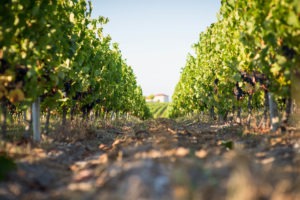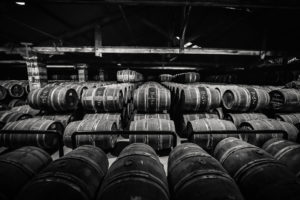Japan always made me dream… Snow-covered Fuji Mount, ‘Sakura’ cherry blossom spinning around, the bumping chopsticks in order to take a shrimp tempura, the blazing kimonos with the little white socks, the Hello Kitty bags of Ganguros girls who are looking at pandas, Nô masks which are scary or funny, sumos who fight in the dust and the spectators screams, Tokyo the city which never stops, the green and peaceful countryside, Kyoto the historical town where we can breath ancestral traditions, the tea ceremony full of conformism and gentleness, the paintbrush which runs on the rice paper and which offers ideogram from another world and the powerful hot saké in a little glass at the end of the meal where we can see a nude lady appears…
I have to confess it: I don’t like saké. I have seen this little glass like a goodwill gesture in an Asiatic restaurant offering Chinese, Japanese, Vietnamese and Korean cuisines in the same time (what a shame !)… Well, a real alcoholic trickery without any interest and tasteless (both literally and figuratively) with this naked chick in the glass bottom as if we were dirty Narcisses ! Well, this time I got wrong : thanks God ! Saké I’ve tasted was far away from the supermarket cereal plonk that people served us with Fortune Cookie !
Sake consumption increases especially abroad and is becoming an alcohol which teases more and more tasters. One of the biggest proof is for instance the first sake exhibition in Paris which took place in June 2013. So let’s chuck out the pseudo saké and let’s pay tribute to this Nipponese beverage which needs an unique know-how and which is the unification symbol of tradition and modernity. Because now I can say: I love saké !
“Sake for the body. Haiku for the heart”
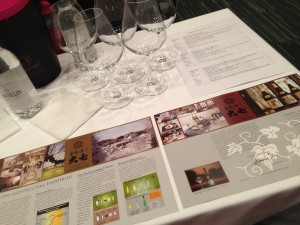
Daishichi saké is one of the most famous and recognized in Japan. Hideharu Ohta San is the General President Director of this firm which exists since 1752. Dressed in a black suit, black tie and white shirt, Sir Ohta San welcomed us with a very nice courtesy before making his introduction speech. With his shiny black hair with a left part, the beard and the mustache well cut, he introduced us to Ad Blankestijn, who is a Saké Master (this is quite rare because he is European). Ad Blankestijn did the tasting with us.
Saké is not really a spirit… We can link this alcohol with beer because there is no distillation but a mash transformation in alcohol with a sugar creation. But in another hand, the alcohol degree is closer to wine than to beer. Synonymous of Umami which is the fifth taste (salty, sweetness, acidity and bitterness) and means ‘delicious’, back in the time, saké was only for men and was drank at the imperial Court. A saké tasting is like a tasting wine: we are looking for the color and the tears, then we smell the first nose. It’s not really common to swirl the saké but Europeans are doing it… so let’s do it if you want! Then the tasting begins with a little bit of saké in the mouth you will split. But before talking about this Japanese pearls, let’s see how a saké is done in the Daishichi brewery.
Daishichi is trying since its creation to mix tradition, innovation and aestheticism. Located in the city of Nihonmatsu in the north of Japan close to the sad town of Fukushima, the firm is doing everything to respect a craft way of production: the Kimoto method. The cold climate of the region is perfect to create saké (the ideal temperature for fermentation is around 9°) and the clear water we can find in these uninhabited areas of Honshu is also ideal. Rice is not like grapes: there is no varietal aromas. It’s water which gives the ‘terroir’ expression. Moreover, rice is coming from different parts of Japan : Saké breweries haven’t rice fields. It exists between 80 and 100 types of saké rices (different of the table rice) and the most famous is the Yamada Nishiki produced in the Kobe area.
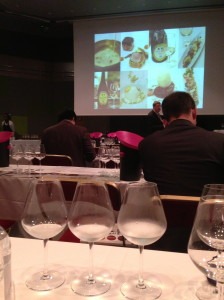
To create saké, first you have to collect the rice. Then you have to polish it: they take the proteins around the grain off in order to keep the heart full of pure starch safe. The polishing determines the saké quality. The Ginjo (Premium) saké or Daiginjo (Super Premium) saké have known a heavy polishing of 50% minimum. At Daishichi brewery, the rice put up an ultra-flat polishing which allows to create an excellent saké. Then, the next step is the grains washing. The grains are plunged in water: the saké master has to check the imbibing of the grains minute by minute. The rice full of water will be steamed afterward. 20% of the rice will be taken to be sprinkled by Koji spores. In two days, the mushroom which is a rot has grown and covered the rice with its white hair. The enzymes produced by Koji will transform starch in sugar.
Finally, the fermentation can take place: this is an important step. The classical method mix the 20% of Koji rice with the 80% of steamed rice with lactic acid and yeasts. This stage will last 10 days and so yeasts will produce alcohol and Koji will continue to create sugar. Fermentation is a low temperature fermentation (10 to 15° degrees and even less for really good saké like in Daishichi). The Kimoto method used at Daishichi brewery has been created during the 17th century (Edo period). On the contrary of the classical method which is used by 99% of the Japanese saké where the yeasts are added with lactic acid, the Kimoto method is a complex way to create this lactic acid naturally. Rice is mixed with Koji rice and water: the mash will be grind (Yamaoroshi) then heat up : the lactic bacterias will develop. The saké yeasts are then added around the 15th day. The mash will be cool down around the 25th day. The fermentation lasts 30 days (10 days in the classical way). At the end, it’s Moromi : the birth of saké.
The saké is filtered: they put the mash in hanging bags, the saké will fall down or they will press the mash directly. The saké can be directly drunk. But also here there are two types of saké : Junmai saké which is pure (no alcohol added) or non-Junmai or Honjozo : rice alcohol has been added in the bags in order to allow to the esters (responsible of fruity flavors) to fall down. Let’s see what Daishichi proposes us!
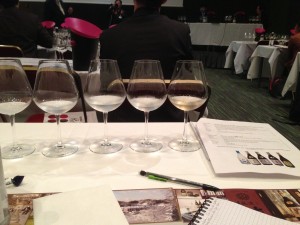
– Yukishibori Nigori (Squeezed snow), Grade Honjozo, 14%.
It’s a lightly sparkling saké done with the traditional method and which has made a second fermentation in the bottle. Created with Gohyakumangoku rice, it’s milky in the glass, it’s like someone just served me coconut water ! Very aromatic with white fruits notes like pear, I smell also some milky notes. I reminds me very fresh steaming rice. Apple comes next with grenadine milk (I know, some of my tasting comments are weird!). The mouth is fresh and lightly sparkling. I feel tasting notes of rice with sweetness. Apple is here again : the yellow apple with its wrinkled skin, the one you have to cook quickly in an apple cake or you will throw away. I also taste something which fermented. It’s so fresh! I like it! It’s very nice to drink and at the finish a little brioche appears. All is really delicate…
– Masakura (True Cherry Blossom), Grade Junmai Ginjo, 15%.
Created with Gohyakumangoku rice, this saké is totally transparent, the cold is coming up around the glass and is in a fog ! The nose is fresh on fermented flavors. Apple, tea and green apple in the second nose… The whole saké is light, delicate and icy fresh. I have the impression to smell a vanilla ice-cream. The mouth is also fresh with milky chocolate notes. There is a nice sweetness and I don’t smell alcohol. The Lu cookie taste arrives in finish with pear and at the really end a little green olive touch appears. It’s really nice !
– Minowamon (The name of the main gate of Nihonmatsu Castle), Grade Junmai Daiginjo, 15%.
Always limpid and transparent, this saké is created with the famous Yamada Nishiki rice and has got a more delicate and discrete nose. There is always this interesting fermented side with a lightly light lemon. Apple again, yellow and riped with this icy impression. Sweetness is less present as Masakura but finally it appears progressively. The mouth is also discrete, more floral with white peach flavors. The smog of the steam rice surrounds me (quite aromatic) but it’s not aggressive. The finish reminds me green olive again!
– Hôreki (The name of the era in which Daishichi was founded), Grade Junmai Daiginjo, 16%.
Yamada Nishiki gives a transparent and light saké with ripe apple and mature pineapple notes… I smell less rice flavors but more fruits. The whole saké is fresher and has more acidity. The mouth is subtle, smooth with acidity. Apple, pineapple, pear. We stay on the same aromas with freshness (nice consistency). Alcohol is lightly stronger and that gives light bitterness at the end. Moreover a saline note appears finally.
– Kimoto Umeshu (Plum saké), Grade Junmai with superior Nanko Umé plums, 12%.
The Gohyakumangoku rice is melted with superior quality plum Nanko Umé, the most famous in Japan. The color is different: it’s a light gold in the glass and the nose is incredible !! It’s my crush of the day! I felt in love with this beverage… I smell Morello cherry then almond. No, it’s more barley water. But finally, the flesh of prune is the best descriptive. The flesh of an aromatic and juicy prune… Very gourmand, with acidity and sweetness in the same time… The second nose confirms the prune flavor. The mouth is delicious… Oh la la!! I think I’m gonna live in Japan ! Acidity and sweetness, the mouth is very well-balanced. I’m tasting a candy. A fresh prune very nice is still there and then vanilla appears. Acidity persists and the prune flesh explodes in the finish. Magical!
Daishichi is creating high quality saké. But a shadow is present: the brewery is not so far from the Fukushima city. Sadly famous for the tsunami in 2011, the nuclear accident took place in the North of Tokyo. Daishichi has chosen transparency and explains the measures taken. The head office assures that the production site has not been directly touched by the radiation wave (there are at 60 km of the nuclear power station) but that the initial explosion of hydrogen has probably touched the area. In order to fight that high performance filters have been put on ventilation. No dusts can enter in the installations. Shutters have been put in the bottling section: no air from outside can penetrate. NaI cases are used everyday to verify the radiation content. Daishichi is the first firm to use a vacuum bottling system (anorexia system) which allows to protect saké of the air and of a possible oxidation.
Concerning the water, it comes from an underwater spring of Naka Ido. Studies which have been done in Tchernobyl have showed that radiations are not entering the ground. So the water is not contaminated. A Gemanium detector is also used to verify the water pollution level. No anomaly has been found for the moment. The water used to wash the cellars comes from the town council and is followed regularly. Concerning the rices: they come from different regions far away from Fukushima. All the rices lots are verified before and after the polishing. The plums origins are also far from the nuclear area.
These are all the measures taken by Daishichi to clean and to keep clean its brewery. Well, it’s what is explained on the website.

